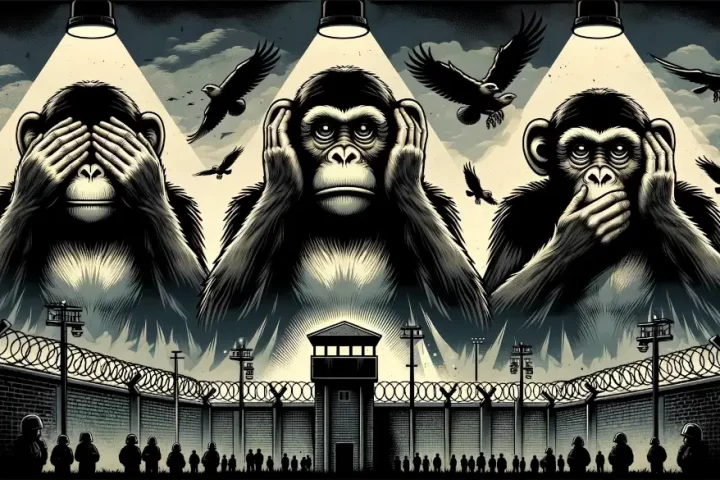Totalitarianism represents the most extreme form of authoritarianism, characterized by an absolute concentration of power in the hands of a single entity, often a dictator or a political party. Life under totalitarian rule is marked by severe restrictions on personal freedoms, pervasive government surveillance, and the suppression of dissent. This article delves into the profound impact of totalitarian regimes on society, illustrating these effects through historical and contemporary examples.
Key Takeaways:
Comprehensive Control and Suppression: Totalitarian regimes exercise complete control over political, social, and economic aspects of life. They maintain power through political repression, surveillance, propaganda, and suppression of dissent, creating a climate of fear and conformity.
Historical and Contemporary Examples: Notable historical examples of totalitarian regimes include Nazi Germany under Hitler and the Soviet Union under Stalin. Contemporary examples like North Korea and aspects of governance in China and Saudi Arabia demonstrate that totalitarianism remains a significant global issue.
Profound Impact on Individuals and Society: Life under totalitarian rule leads to severe restrictions on personal freedoms, economic hardships, and significant psychological impacts. The constant threat of surveillance and punishment fosters fear and mistrust, resulting in long-lasting trauma and societal stagnation.
Table of Contents
- Understanding Totalitarianism
- Definition and Characteristics
- Historical Examples of Totalitarian Regimes
- Life Under Totalitarian Rule
- Political Repression and Surveillance
- Impact on Society and Individuals
- Examples of Totalitarianism in the United States
- Examples of Oppressive Government Actions in the United States
- Conclusion
- FAQs
- What are the main characteristics of totalitarian governments?
- How do totalitarian regimes maintain control over their populations?
- Can a country be both authoritarian and totalitarian at the same time?
- What are some historical examples of totalitarian regimes?
- How do totalitarian regimes affect individuals psychologically?
- What is the impact of totalitarian control on the economy?
- References
- The Use of External Resources:
Understanding Totalitarianism
Definition and Characteristics
Totalitarianism is a form of government where the state holds total authority over society and seeks to control all aspects of public and private life. Unlike authoritarian regimes that maintain power primarily through political repression and limited political pluralism, totalitarian regimes aim for complete political, social, and cultural control. Characteristics of totalitarian regimes include:
- Centralized control by a single party or leader
- State propaganda and mass media control
- Suppression of political dissent and freedom of expression
- Extensive use of surveillance and secret police
- Ideological indoctrination
Historical Examples of Totalitarian Regimes

Nazi Germany
Nazi Germany, under Adolf Hitler from 1933 to 1945, is one of the most infamous examples of a totalitarian regime. The Nazi government exercised total control over the German state, employing propaganda, state terrorism, and the elimination of political opposition to maintain its grip on power. The regime’s policies led to the genocide of six million Jews in the Holocaust, along with the persecution of other minority groups and political dissidents.
Stalinist Soviet Union
Under Joseph Stalin’s rule from the mid-1920s until 1953, the Soviet Union became a prime example of a totalitarian state. Stalin’s regime was marked by widespread purges, forced collectivization, and the establishment of a cult of personality. The state controlled all aspects of life, including the economy, education, and culture, and used the secret police (NKVD) to enforce compliance and eliminate perceived threats.
Contemporary Totalitarian Regimes
North Korea
North Korea, under the leadership of the Kim dynasty, exemplifies a modern-day totalitarian regime. The government maintains strict control over all aspects of life, including the economy, media, and even personal relationships. The regime employs a pervasive surveillance system and harsh punishments for dissent. The population is subject to intense indoctrination and propaganda, with a strong emphasis on the cult of personality surrounding the Kim family.
China
While China is often classified as an authoritarian state, certain aspects of its governance under the Chinese Communist Party (CCP) exhibit totalitarian characteristics. The CCP maintains strict control over the media, internet, and education, employing extensive surveillance and social credit systems to monitor and influence citizen behavior. The treatment of ethnic minorities, such as the Uyghurs in Xinjiang, and the suppression of political dissent, such as in Hong Kong, demonstrate the regime’s totalitarian tendencies.
Saudi Arabia
Saudi Arabia is typically seen as an authoritarian state, but it also exhibits features of totalitarianism. The Saudi government exercises significant control over the media, restricts political freedoms, and enforces strict social norms through religious police. The regime’s severe punishment for dissent and the lack of political pluralism illustrate its totalitarian aspects.
Life Under Totalitarian Rule

Political Repression and Surveillance
One of the hallmarks of totalitarian regimes is the extensive use of political repression and surveillance. Governments maintain power by eliminating political opposition and closely monitoring their citizens. In Nazi Germany, the Gestapo (secret police) played a key role in rooting out dissent and enforcing the regime’s policies. Similarly, in the Soviet Union, the NKVD conducted mass arrests and executions to suppress any potential threats to Stalin’s rule.
In contemporary North Korea, the state uses a vast network of informants to monitor citizens’ behavior and loyalty. Those suspected of disloyalty face severe punishment, including imprisonment in brutal labor camps. China’s sophisticated surveillance system, including widespread use of facial recognition technology and internet monitoring, allows the government to maintain tight control over its population.
Propaganda and Ideological Control
Totalitarian regimes rely heavily on propaganda to maintain their grip on power and control the population’s beliefs and attitudes. State-controlled media disseminate propaganda that glorifies the regime and its leaders while vilifying enemies, both foreign and domestic. In Nazi Germany, Joseph Goebbels, the Minister of Propaganda, used films, newspapers, and radio broadcasts to promote Nazi ideology and anti-Semitic rhetoric.
In North Korea, state media continuously praises the ruling Kim family and promotes the regime’s Juche ideology, emphasizing self-reliance and nationalism. Chinese state media similarly propagates the achievements of the Communist Party and censors content that could undermine its authority.
Suppression of Dissent
Totalitarian governments suppress any form of dissent to prevent challenges to their authority. This suppression often involves censorship, imprisonment, and even execution of political opponents. During Stalin’s Great Purge, millions of people were executed or sent to labor camps on charges of being “enemies of the state.” In Nazi Germany, political opponents, Jews, and other minorities were systematically persecuted and exterminated.
Today, North Korean defectors report that dissent is met with harsh punishments, including execution and imprisonment in labor camps. China’s crackdown on pro-democracy activists in Hong Kong and the internment of Uyghurs in Xinjiang are contemporary examples of the suppression of dissent in a regime exhibiting totalitarian traits.
Impact on Society and Individuals
Loss of Personal Freedoms
Under totalitarian rule, individuals experience a significant loss of personal freedoms. The state controls many aspects of daily life, including where people can live, work, and travel. In North Korea, citizens need government permission to move between regions, and access to information from outside the country is severely restricted.
In Nazi Germany and Stalinist Russia, citizens faced constant surveillance and the threat of being reported to authorities by neighbors or colleagues. This climate of fear stifled free expression and led to widespread self-censorship.
Economic Control
Totalitarian regimes often exert control over the economy to maintain power and implement their ideological goals. Stalin’s Soviet Union implemented forced collectivization of agriculture, leading to widespread famine and the death of millions. The state’s control over industrial production aimed to rapidly transform the Soviet Union into an industrial superpower, often at the cost of workers’ rights and well-being.
North Korea’s command economy has resulted in chronic food shortages and economic stagnation. The regime prioritizes military spending and the development of nuclear weapons over the needs of its people, leading to widespread poverty and malnutrition.
Psychological Impact
Living under a totalitarian regime has profound psychological effects on individuals. The constant surveillance, fear of punishment, and propaganda can lead to a sense of powerlessness and mistrust among citizens. In North Korea, the regime’s control over information and intense indoctrination create an environment where citizens are isolated from the outside world and deeply mistrustful of each other.
Survivors of Stalin’s purges and the Holocaust often describe long-lasting trauma from their experiences. The constant threat of violence and the loss of loved ones left deep psychological scars that affected individuals for the rest of their lives.
Examples of Totalitarianism in the United States
While the United States is fundamentally a democratic nation, there have been moments in its history that exhibit totalitarian tendencies. The internment of Japanese Americans during World War II, where over 100,000 individuals were forcibly relocated and imprisoned in camps, reflects a period of extreme government control and suppression of civil liberties based on ethnicity.
The Red Scare and McCarthyism of the 1950s saw the government and private institutions blacklisting individuals suspected of Communist sympathies, leading to widespread fear and suppression of political dissent. These instances serve as reminders of the dangers of totalitarianism and the importance of protecting democratic principles.
Examples of Oppressive Government Actions in the United States
Treatment of Native Americans
The United States’ treatment of Native Americans, particularly during the 19th and early 20th centuries, reflects many oppressive and authoritarian practices. This period was marked by policies aimed at displacing Native Americans from their ancestral lands, eradicating their cultures, and assimilating them into American society. Key examples include:
- Forced Relocations and Reservations: The Indian Removal Act of 1830 authorized the forced relocation of Native American tribes from their homelands in the southeastern United States to designated “Indian Territory” west of the Mississippi River. This led to the infamous Trail of Tears, during which thousands of Native Americans died due to harsh conditions.
- Cultural Suppression: The U.S. government implemented policies aimed at eradicating Native American cultures and languages. Native children were taken from their families and placed in boarding schools where they were prohibited from speaking their native languages and practicing their cultural traditions.
- Land Seizures and Treaties: Numerous treaties made between the U.S. government and Native American tribes were broken, often resulting in the seizure of land and resources. The discovery of gold in the Black Hills, for example, led to the violation of treaties with the Sioux Nation and the subsequent conflicts, such as the Battle of Little Bighorn.
- Economic and Social Control: The reservation system severely restricted the economic opportunities and autonomy of Native American communities. Policies were designed to assimilate Native Americans into the dominant culture, often through coercive means.
While these actions are not totalitarian in the strictest sense—lacking the pervasive surveillance and ideological indoctrination typical of totalitarian regimes—they do represent severe oppression and authoritarian control. The U.S. government’s treatment of Native Americans involved systemic and institutionalized efforts to control and suppress a population, illustrating the darker chapters of American history.
Conclusion
Life under totalitarian rule is marked by severe restrictions on personal freedoms, pervasive government control, and the suppression of dissent. Historical and contemporary examples from Nazi Germany, the Soviet Union, North Korea, and China illustrate the profound impact these regimes have on society and individuals. Understanding the characteristics and consequences of totalitarianism is crucial for recognizing and resisting its emergence in any form.
FAQs
What are the main characteristics of totalitarian governments?
Totalitarian governments are characterized by centralized control of power, suppression of political dissent, extensive use of surveillance, control over the media and propaganda, and the imposition of an official ideology. These regimes seek to control all aspects of public and private life.
How do totalitarian regimes maintain control over their populations?
Totalitarian regimes maintain control through a combination of political repression, surveillance, propaganda, and the suppression of dissent. They use secret police and informants to monitor and punish dissent, control the media to disseminate propaganda and implement policies that limit personal freedoms and control the economy.
Can a country be both authoritarian and totalitarian at the same time?
Yes, a country can exhibit both authoritarian and totalitarian characteristics. Authoritarian regimes primarily focus on maintaining political power, often through limited political pluralism and repression. Totalitarian regimes go further, seeking to control all aspects of life, including the economy, education, and culture. Countries like North Korea and China display both authoritarian and totalitarian traits.
What are some historical examples of totalitarian regimes?
Historical examples of totalitarian regimes include Nazi Germany under Adolf Hitler, the Soviet Union under Joseph Stalin, and Maoist China. These regimes were characterized by centralized control, suppression of dissent, extensive surveillance, and state propaganda.
How do totalitarian regimes affect individuals psychologically?
Living under totalitarian rule can lead to significant psychological effects, including a sense of powerlessness, fear, and mistrust. The constant surveillance and threat of punishment create a climate of fear that stifles free expression and leads to widespread self-censorship. Survivors of such regimes often experience long-lasting trauma.
What is the impact of totalitarian control on the economy?
Totalitarian regimes often exert control over the economy to achieve their ideological goals, which can lead to economic inefficiencies, shortages, and widespread poverty. Forced collectivization, as seen in Stalinist Russia, led to famine and the death of millions. North Korea’s command economy has resulted in chronic food shortages and economic stagnation.
References
- Arendt, H. (1951). The Origins of Totalitarianism. Harcourt, Oxford Academic.
- Gleason, A. (1995). Totalitarianism: The Inner History of the Cold War. Oxford University Press.
- “North Korea: The Last Totalitarian State,” BBC News.
- “Stalin’s Soviet Union: A Reign of Terror,” History.com.
- “China’s Surveillance State,” The Guardian.
Here are some reliable sources that provide information on the treatment of Native Americans by the U.S. government:
- Trail of Tears and Forced Relocations:
- Cultural Suppression and Boarding Schools:
- Broken Treaties and Land Seizures:
- Economic and Social Control:
The Use of External Resources:
These sources provide detailed historical accounts and analyses of the U.S. government’s actions against Native Americans, illustrating the oppressive and authoritarian nature of these policies.
The sources are reputable academic publications, historical websites, and recognized news organizations.
